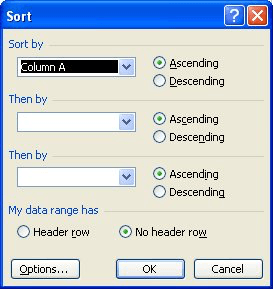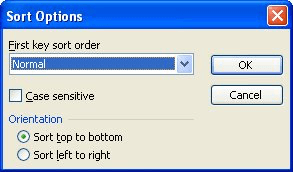Please Note: This article is written for users of the following Microsoft Excel versions: 97, 2000, 2002, and 2003. If you are using a later version (Excel 2007 or later), this tip may not work for you. For a version of this tip written specifically for later versions of Excel, click here: Controlling Sorting Order.
Written by Allen Wyatt (last updated July 25, 2020)
This tip applies to Excel 97, 2000, 2002, and 2003
If you have used Excel for more than a week, you probably already know how to sort information in your worksheet. You can use sorting to arrange a list in either ascending or descending order. Ascending order for the English language is from 0–9, A–Z; descending order is the reverse. The sorting order for other languages will be different. To specify the sorting order you simply choose the Ascending or Descending radio buttons in the Sort dialog box.
You can also affect sort order by indicating whether Excel should pay attention to the case of the text in your cells. If a sort is case sensitive, then items are sorted A-Z and then a-z for ascending sorts. If a sort does not pay attention to case, then uppercase and lowercase letters are treated the same.
To specify whether Excel should pay attention to case, follow these steps:

Figure 1. The Sort dialog box.

Figure 2. The Sort Options dialog box.
ExcelTips is your source for cost-effective Microsoft Excel training. This tip (2921) applies to Microsoft Excel 97, 2000, 2002, and 2003. You can find a version of this tip for the ribbon interface of Excel (Excel 2007 and later) here: Controlling Sorting Order.

Excel Smarts for Beginners! Featuring the friendly and trusted For Dummies style, this popular guide shows beginners how to get up and running with Excel while also helping more experienced users get comfortable with the newest features. Check out Excel 2019 For Dummies today!
Sorting information in a worksheet can be confusing when Excel applies sorting rules of which you are unaware. This is ...
Discover MoreNeed to sort your data based on the color of the cell? Excel doesn't include this capability, but you can still do the ...
Discover MoreWant to sort addresses by even and odd numbers? By using a formula and doing a little sorting, Excel can return the ...
Discover MoreFREE SERVICE: Get tips like this every week in ExcelTips, a free productivity newsletter. Enter your address and click "Subscribe."
There are currently no comments for this tip. (Be the first to leave your comment—just use the simple form above!)
Got a version of Excel that uses the menu interface (Excel 97, Excel 2000, Excel 2002, or Excel 2003)? This site is for you! If you use a later version of Excel, visit our ExcelTips site focusing on the ribbon interface.
FREE SERVICE: Get tips like this every week in ExcelTips, a free productivity newsletter. Enter your address and click "Subscribe."
Copyright © 2025 Sharon Parq Associates, Inc.
Comments